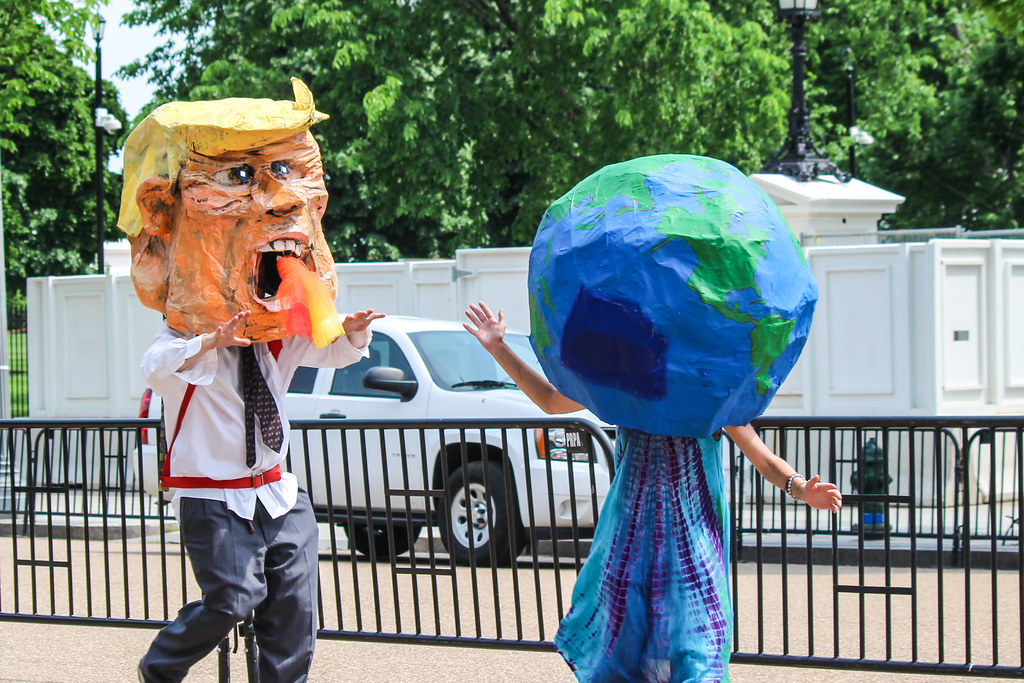On 1 June 2017, the 45th President of the US, Donald Trump, announced his government’s withdrawal from the Paris Agreement. The announcement, though disappointing for the global community, was expected. As such, statements from major greenhouse-gas emitters such as China and the EU were ready to be released shortly after Trump’s withdrawal speech. The message from world leaders is clear: there is no intention of abandoning an agreement that has taken over five years to negotiate and there is no possibility of renegotiation at the request of a single nation. The world will move forwards towards a low-carbon future despite Trump’s efforts to hold it back. The environment, the economy and the people need a low-carbon transition.
The withdrawal and renegotiation announcement by President Trump has been heavily criticised. It makes little sense to try to renegotiate an agreement that is legally binding on procedural issues, which is based on Nationally Determined Contributions (NDCs) that countries voluntarily submitted, and which takes into account the principle of common but differentiated responsibilities and respective capabilities while being mindful of national circumstances. No country imposed any obligations on others, either in terms of reducing GHG emissions or as regards contributions to the Green Climate Fund. The hybrid nature of the agreement –with rule development, oversight and five-year reviews taking place at the international level, and contributions decided at the domestic level– ensures voluntary pledges that are in the countries’ own interests.
“Trump based much of his withdrawal speech on the cost of climate action. However, there are a number of reasons why his arguments are highly questionable”
Trump based much of his withdrawal speech on the cost of climate action. However, there are a number of reasons why his arguments are highly questionable: the study he cited did not include the benefits of action (ie, ignored the costs of inaction), innovations and evolving technology costs were ignored, and labour market figures were both misunderstood by Trump and incomplete in the study. Nevertheless, analysing the labour market consequences of a low-carbon transition and ensuring a just transition for workers is a relevant and, to date, underexplored issue. Designing measures in national climate laws that are in the making to ensure workers can adapt to a low-carbon economy will, probably, increase the likelihood of citizens buying-in climate policies.
In addition to the above, Trump’s claim that full implementation of the NDCs would only reduce temperatures by 0.2ºC is arguably underestimating the impact of the full implementation of the Paris Agreement. The MIT states that full implementation of the Paris Agreement would lead to a reduction in global mean surface air temperature (SAT) of between three and 5.5 times higher than claimed by Trump. This means a reduction in SAT of between 0.6ºC and 1.1ºC by the end of the century compared with a no-policies scenario. While this is insufficient to limit global mean temperature increases to well below 2ºC compared with preindustrial levels, as full implementation will mean overshooting the 2ºC guardrail by about one degree, it is hardly insignificant progress. Additionally, big emitters such as China and India are recognised to be on track to over-complying with their initial Paris commitments, partially counteracting the US rollback of federal climate regulations.
What does US withdrawal from the Paris Agreement mean? The consequences can be analysed both within the US and internationally. For the US, withdrawal implies single-handedly isolating itself from the international climate diplomacy community, a move that damages its credibility as a trustworthy partner in negotiating global matters. It also means squandering the political capital invested in designing the key features of the agreement and its rulebook and frustrating climate negotiators worldwide. Frustration will arguably result from the fact that the architecture of the Paris Agreement was in part designed to suit US political constraints.
“US withdrawal from the Paris Agreement has also effectively erased the global climate leadership the Obama Administration nurtured”
US withdrawal from the Paris Agreement has also effectively erased the global climate leadership the Obama Administration nurtured, especially during his second term in office. States, cities and American corporations are, however, manifesting their intention of pushing ahead with ambitious commitments. In fact, after Trump’s announcement it was reported that Michael Bloomberg is leading a group of mayors, governors, university chancellors and companies in negotiating the acceptance of their commitment pledges under the UNFCCC along with those of other parties. Currently, non-state actor pledges are held under the Non-State Actor Zone for Climate Action (NAZCA) platform and the 2050 pathways platform, among others.
Further consequences of US paralysis on climate action could include transition risks such as those identified by the Task Force on Climate-related Financial Disclosures. One such example is the US government’s greater exposure to climate-related litigation, a concern voiced by Trump during the withdrawal speech that is unlikely to be circumvented by withdrawing from the Paris Agreement. Additional transition risks that can be faced by the US and its companies are related to the market opportunities forgone in competing for the demand for low-carbon goods and services (estimated to be worth US$4.2 trillion), the loss of reputation and facing sectorial stigmatisation.
For the world, losing the second-largest GHG emitter in the global fight against climate change is not good news. Preventing dangerous interference with the climate system will become harder after Trump’s withdrawal announcement. US non-state actors and the remaining parties to the Paris Agreement now have the task of filling the void left by yet another US climate default (the first being its failure to ratify the Kyoto Protocol). It also becomes more expensive for developed countries to meet the Copenhagen, Cancun and Paris pledges, including the commitment to disburse US$100 billion annually from 2020 onwards to foster mitigation and adaptation by less developed countries.
Now more than ever, leadership by the EU and China is essential to drive the world’s transition to a low-carbon future, but they will need other regions and actors to collectively implement current commitments and should rise to the occasion to respond to one of the world’s most pressing challenges.


